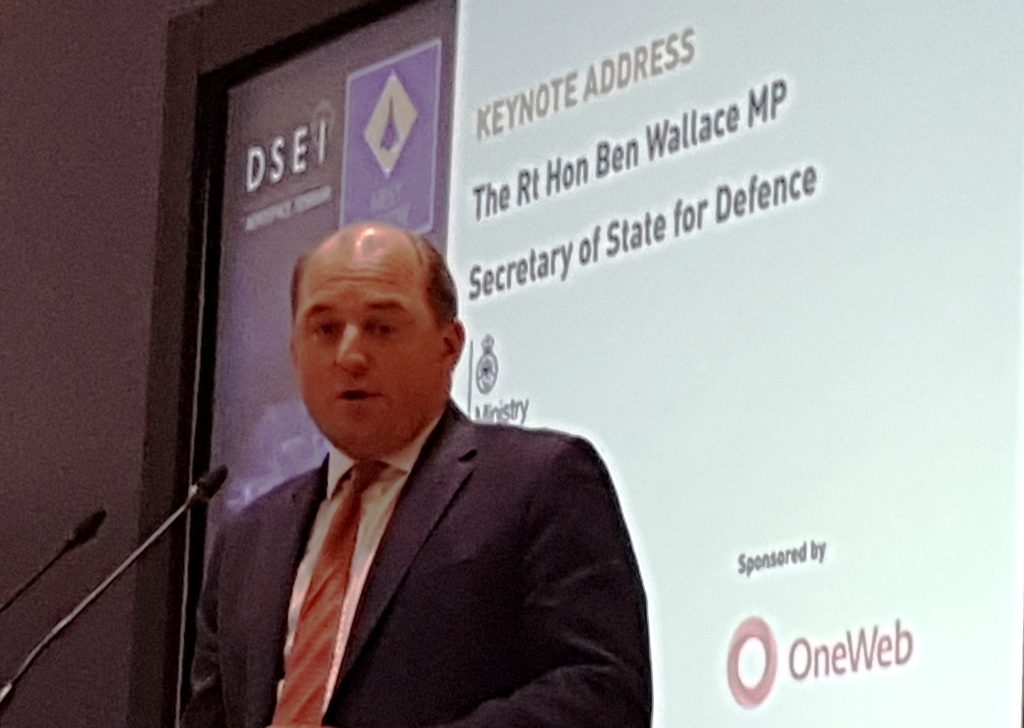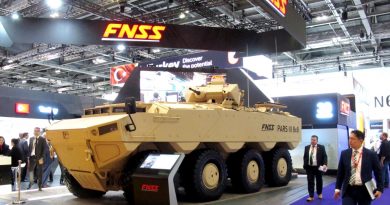
Defence Secretary Champions Defence Industry
By Ian Kemp
UK Secretary of State for Defence Ben Wallace told visitors to DSEI 2019 that if they “take home one message from the UK, it is this – we are global. We are alive to the global threats. And we have the world class industrial base and the game-changing capability to deal with the danger.”
Wallace stated the “Defence industrial base remains the spine of our nation, allowing our forces to be the tip of our spear for Global Britain.” He noted that the defence industry sector, the second largest in the world accounting for 19% of global export value over the past decade, brings in annual sales worth more than £19 billion to the UK economy.
“There is always the challenge of selling to wider Government what we in Defence do. It is true that what our Armed Forces do is often over a distant horizon, or below the deep ocean. But the reality is, what we do, makes an enormous global difference. Defence is often upstream focusing on keeping danger away from these shores.”
The Defence Secretary was speaking on the 18th anniversary of the 11 September 2001 terrorist attacks on the USA. “For many it was the first awakening of the full horror of global terrorism. But it was because of our investment in Defence, because of the strength of our capability, that the UK was able to fight alongside our allies. And because of key procurement decisions we were able to operate side-by-side across the globe.”
Wallace cited the example of “taking the fight to Daesh in the past few years with our Typhoons, attacking the terrorists both day and night with power and precision, while our cyber capability eroded their communication channels and exposed the so-called caliphate for the sham it always was.”
“In more recent times, when the arteries of worldwide trade have been threatened by hostile Iranian state action in the Strait of Hormuz, we’ve enlisted the global capacity of our Type 23s [frigates] and Type 45s [destroyers], built on shipyards on the Clyde, to defend the red ensign. And, with Hurricane Dorian ravaging the Caribbean, we were the first nation to send support, dispatching RFA Mounts Bay, equipped with amphibious vehicles and helicopters to work alongside international aid colleagues, providing residents in the Bahamas with much needed humanitarian help.”
These examples, he said, provide “a stark demonstration of Britain’s ability to match global capability with global presence to deal with any eventuality. But that what’s so remarkable about the British defence industry, is that we have strength and depth.”
The Defence Secretary acknowledged that the government has “to break the traditional cycle where our appetite didn’t match our stomachs which led to the annual hollowing out of capability and plans, which ultimately lets down the men and women of our Armed Forces. We have to invest in our global defence force if we want to make a global difference and last week’s Spending Round announcements signalled our intent.”
Chancellor of the Exchequer Sajid Javid detailed the Conservative government’s spending plans on 4 September 2019, increasing the defence budget by £2.2 billion to over £41 billion by 2020-21, the first time it has exceeded £40 billion, and ensuring that the UK meets the NATO goal of spending 2% of GDP on defence.
“It means that the UK remains the largest NATO defence spender in Europe by far,” stressed Wallace. “Above all, it means more money to keep investing in key capabilities such as offensive cyber, nuclear deterrent and shipbuilding. Defence will always continue to require sustained investment for the long-term.”
“Today 11 major warships are in build or on contract not to mention our next-generation of nuclear deterrent submarines. We’re looking to build Type 31 frigates and we’re building Type 26 Global Combat Ships, whose designs have won plaudits and contracts in Australia and Canada.” BAE Systems Maritime – Naval Ships is building eight Type 26 frigates for the Royal Navy and the design was selected as the basis for Australia’s nine Hunter-class frigates and Canada’s 15 Canadian Surface Combatants.
“Switching from sea to land, our Army is upgrading not only our Challenger 2 and Warrior vehicles but bringing in Multi-Role Armoured Vehicles to operate alongside Ajax, with a main gate decision due at the end of October.” Following the 2016 decision to restructure the British Army from three armoured infantry brigades into two armoured and two Strike brigades, the defence industry has been nervously awaiting a decision on how many Challenger 2 main battle tanks and Warrior infantry fighting vehicles will be modernised.
Another project highlighted by Wallace is the work BAE Systems is doing “to develop lighter ammunition, replacing the brass in the cartridge cases with stainless steel or titanium, reducing the load our troops have to carry by up to 26% along with the costs of transporting rounds to the front line. We’re applying the same blue skies thinking to the air domain as well. Last year at Gatwick and Heathrow we saw the peril drone technology poses to our airspace.” From 19-21 December more than 1,100 flights at Gatwick had to be diverted or cancelled because of illegal drone flights around the airport.
Wallace announced at DSEI “that, from early next year, the RAF will be working with Leonardo on a three-year programme, looking at how to detect, track, identify and defeat rogue drones as this technology continues to evolve.
“And I’m pleased that we’ve signed a statement of intent with Italy who, alongside Sweden, will support joint working on the Tempest and our Future Combat Air Strategy. I’m looking forward to working with Italian and Swedish counterparts, as well as others, to put the Tempest programme into hyper-drive and take Global Britain into the stratosphere.”
Wallace acknowledged that in the past the MOD has provided certainty about its spending plans to industry. “But we know that you only produce great kit if you have great partnerships between policy makers and product makers. That’s why I want to see a step-change in our partnership with industry.”
“We’re determined to go out of our way to help you giving you the certainty and confidence you need to create great capability. So, as well as investing we’re planning for the future. A few days ago, we published our Defence Technology Framework. It will help concentrate our collective minds by assessing the technologies needed to drive our defence modernisation and deliver battle-winning technologies.”
Photo by Ian Kemp

